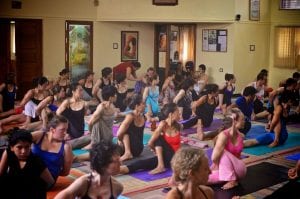
Photo Credit and Copyright: Barbara Suss
Below is a contribution from Darshan Shah, MD, on Yoga and the Innate Ability of the Body to Heal.
“The primary series of Ashtanga Yoga is designed as a systematic method to purify the body and make it healthy. The systematic application of breath, vinyasa, asana, dristhi, and awareness causes highly beneficial physiological adaptations to all body systems. As a physician I have had the privilege to experience and understand its effects.
These effects are important because they connect us with our innate ability to heal. We currently live in a world where many people are suffering from chronic ailments—heart disease, diabetes, cancer, autoimmune disease, anxiety, depression, and obesity. The major culprit that prevents our internal systems from regenerating and recovering is stress.
Stress is a pressure applied to something—an object or a person. For most of us it is not physical pressure that causes us stress, it is what we experience in daily life with our families, jobs, societal norms, and the environment. For example, my time in residency was one of the most stressful periods in my life. I was sleep deprived and felt insecure because I was worried about performing and doing a good job. At lunch I would eat fatty and sugary food because this made me feel better (temporarily). Each month I had to learn a new hospital with different computer systems, order sets, nurses, patients, and doctors. I had more bosses than I could count on my fingers, answering to multiple senior residents, senior nurses, attending physicians, specialists, and ultimately the patient himself. From pediatrics, to gynecology, to cardiology, to a number of other different specialties, I had to learn each as best I could. It was totally overwhelming. I had insomnia, palpitations and lost patches of hair because I was afraid—afraid that I wouldn’t make it. During this time I was 20 lbs heavier and had a band of fat around my waist, indicative of the insulin resistance I was developing. And my cholesterol was sky high. My physiology was being negatively affected by how I was handling stress. Unfortunately, what I experienced is very common, and it is how we deal with stress that ultimately determines the effectiveness of our innate ability to heal.
Numerous studies show how stress damages and prohibits the body’s natural repair mechanisms. The adrenal glands secrete cortisol at elevated levels which then raises blood sugar and blood pressure. Chronically elevated cortisol leads to brittle bones, osteoporosis, insulin resistance and weight gain around the abdomen. It also suppresses the immune system—natural killer cells and macrophages do not work as well. Over time, elevated blood sugar also leads to the formation of Advanced Glycalation Endproducts (AGEs) and eventually diabetes and Alzheimer’s disease. Elevated blood pressure increases the risk of heart disease, stroke, glaucoma, and kidney disease. The list goes on and on.
Thankfully, my wife, Priya, introduced me to Ashtanga Yoga in residency. The practice gave me the tools to manage my body’s response to stress through balancing my nervous system. It is not much different from how we brush our teeth regularly to keep them clean. We know that if we do not do this we will get cavities and have bad breath. Similarly, if we do not regularly cleanse our nervous system or internal channels, known as nadis, we will develop problems related to blocked energy.
The nervous system has a voluntary part and an involuntary part called the Autonomic Nervous System (ANS). The ANS is comprised of two branches, the Sympathetic Nervous System (SNS) and the Parasympathetic Nervous System (PNS). The SNS is what gets activated when we are stressed and raises blood pressure, heart rate, and respiratory rate. It shunts blood away from our gut and our extremities. It is the system that gets activated in the “fight or flight” response, when we feel under threat. The PNS has the opposite effect, and is the “rest and digest” system. It is activated when we relax. It slows our breathing down, and improves blood flow to the gut and to our hands and feet, making us feel warm. The balance maintained in the ANS is very important to our innate ability to heal. When the sympathetic nervous system is overactive, like when we are watching the news, driving a scooter in Mumbai, or when our mother-in-law is at our house— when we are feeling stressed—our self-repair mechanisms do not work as well. We do not digest as well because there is less blood flow to the gut. Our heart works harder and we can feel it thumping. If this SNS stays stimulated for a long period of time, our immune function starts to decline. Antibody production goes down, natural killer cells don’t work as well, and other self-repair mechanisms degrade. Over years, a person with an imbalanced autonomic nervous system will develop problems like a car that has not had it’s wheels aligned—increasing the risk of having a blowout because of asymmetric tire wear.
Ashtanga Yoga is impressive because it systematically engages the sympathetic nervous system in a gentle and purposeful manner, and allows us to settle it into balance with its parasympathetic counterpart. Already, the SNS is over-stimulated by daily living, so it is vitally important that we find ways to calm it down to allow our self-healing mechanisms to function.
The asana and vinyasa, combined, yokes breath with movement. It is specifically through the proper breath that the autonomic nervous system is accessed and control over the SNS is developed. This is where the primary benefit of Ashtanga Yoga is achieved. Without the synchronization of breath, the utility of the asana practice would be significantly limited. As a beginner, even Surya Namaskara can be a difficult posture, and will raise the blood pressure and heart rate. By focusing on the breath, the diaphragm becomes engaged and toned while the wiring and firing of the sympathetic nervous system is modulated. The attention given to breath overrides the sympathetic control of respiratory rate, which wants to accelerate it, but is being held back by conscious control. Regulating the breath while doing asana with vinyasa is what retrains the sympathetic nervous system. Over time, the sympathetic nervous system quiets down and comes into harmony with the rest of our nervous system. An experienced teacher will be able to observe these physiologic changes in his or her student over time, and introduce additional postures to further develop the nervous system of the student.
For the majority of students, the Primary Series of Ashtanga Yoga poses sufficiently provocative postures to stimulate the sympathetic nervous system. Each new posture in the series becomes another opportunity to develop conscious control over the SNS. For a student who systematically goes through the Primary Series, he will improve the strength and resilience of his nervous system. Instead of having wild swings of the autonomic nervous system in relation to stress and stimulation of the SNS, he will stay calm even when things around him appear turbulent.
What I have studied, both through research articles and self-observation with Ashtanga Yoga over time, is that by regulating the autonomic nervous system, and thus stress, we free energy for our innate healing systems to function optimally. Since beginning my practice a number of years ago, I am stronger, more resilient, quiet of mind, and healthier than I have been in the past. As a part of a larger system of observances that include paying attention to how we live and what we eat, it is my anti-aging medicine.”
For anyone interested in learning more about Dr. Darshan Shah and his approach to healing, you can visit Whole Health Austin.
